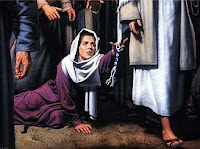HOW THE TZITZIT ARE USED DURING PRAYER AND AT OTHER TIMES
Sh'ma Yisrael Adonai Eloheinu Adonai Ecḥad
"Hear, O Israel: the LORD is our God, the LORD is One."
The tzitzit are used at various times during a service. Just before reciting the Shema prayer, those at prayer gather together the four tzitziot (plural of tzitzit) and hold them, using them to cover the eyes during recitation. Some people suggest that this symbolically helps worshippers focus on the unity of God, and gives them a special awareness that helps them concentrate on the words of the prayer. It is customary to kiss the tzitzit during recitation of Numbers 15:37-41, when the word tzitzit is mentioned as part of the Shema prayer.
Jewish people also use the tzitzit as a way of kissing the Torah during its procession around the synagogue before and after its reading. It is also a custom to take the tzitzit and lift them toward the Torah when it is raised following its public reading. When called up for a Torah honor (the blessing before and after the Torah reading), it is customary to take the fringes and touch the section of the scroll about to be read, kiss the tzitzit, and then recite the blessing before the reading. This procedure is repeated following the reading and before the second blessing.
Traditionally, men are buried in their tallit with a tzitzit cut to make it ritually unfit, since one should not bury a ritual object that is still able to be used. The tallit follows you from birth to death; it is often used to wrap a baby during the ritual of brit milah (circumcision) or baby naming (for girls), and it is often draped across the casket during a funeral. Although the tallit accompanying a deceased person is no longer fit for use, Rabbi Adin Steinsaltz says that it still offers a kind of divine protection for the perilous journey he or she may face.
The tallit is sometimes used as a chuppah (marriage canopy). In addition, it is worn by those carrying the Torah scrolls during the Torah procession in the synagogue prior to and after its reading, as well as on Simchat Torah, the holiday celebrating the completion of the yearly cycle of Torah reading.
WOMEN AND WEARING A TALLIT
In writing an introduction on Jewish rituals, we run the risk of giving readers the mistaken impression that, because we state things in a direct manner, the issues we address are relatively free from complication. For example, women in liberal synagogues may wear a tallit if they choose, while women in Orthodox synagogues are not allowed to wear a tallit – plain and simple. Well, actually not so simple.
Throughout history, some Orthodox Jewish scholars have argued for allowing women to wear talliot (plural of tallit). The Talmud (Menachot 33b) records a debate on this subject between two Rabbis: one permits women to wear a tallit and the other does not. While no one knows who won the debate, we can see that, almost two thousand years ago, some women were doing something that is not permitted today in many circles. In fact, the great medieval Jewish scholar Maimonides wrote in his collection of Jewish law that women may wear tzitzit if they so desire (Hilkhot Tzitzit 3:9). They are not obligated to do so, as men are, but they are not prohibited from doing so either. Orthodox women today do not wear a tallit because of religious and cultural norms. But because there is some basis in Jewish sources for women wearing a tallit, there may yet come a time in the Orthodox world when this becomes accepted practice.
CHRISTIAN PARALLELS TO WEARING TZITZIT
Just as with the wrapping of tefillin, the Gospels suggest that Jesus himself wore tzitzit (on a tallit). The Gospel of Mark says that the ill would grab hold of "the fringe of his garment" (Mark 6:56, and in particular also the passage of the bleeding woman, Matthew 9:20–22, Mark 5:25–34, Luke 8:43–48, etc.). The word used for "fringe" in this passage, the Greek word kraspedon, is also the word used for tzitzit.* Thus, some scholars infer that Jesus, as a ritually observant Jew, wore tzitzit.
Despite this mention in the Gospel, the practice of wearing tallit katan did not become a part of the early Christian tradition, and remains rather unique to Judaism, since it represents a way of literally wrapping yourself in God's commandments and acknowledging God's constant presence in your life. There are, however, come Christian parallels to the practice: many Christians wear a cross around their neck at all times, affirming their faith in Jesus; others wear the medal of a particular saint as an acknowledgement of God's presence in their life and the values represented in the saint's life; some members of monastic orders wear a scapular under their clothing – a small, woollen cloth that reflects, as the tallit does, a constant commitment to religious values; and some churches, particularly independent apostolic churches, have chosen to use liturgical vestments very similar to the tallit, which are seen as related to the original priestly garb of the ancient Temple in Jerusalem.
Another interesting Christian parallel to the wearing of a tallit comes from the Church of Latter Day Saints (the Mormons). Just as a tallit katan is worn under clothing, Mormon tradition holds that followers wear a special garment beneath their clothes. Some speculate that this practice originated because the founder of the Mormon Church studied Hebrew with an observant Jew. Similar to the rabbinic story related previously – about the man whose tallit keeps him from sleeping with a prostitute – there is a Mormon story that says this special garment keeps a man from sleeping with a woman who tries to seduce him, only to eventually marry her after she becomes a pious woman.
____________________
* Paula Fredriksen, Jesus of Nazareth, King of the Jews, (Vintage Books, 2000), 109.



